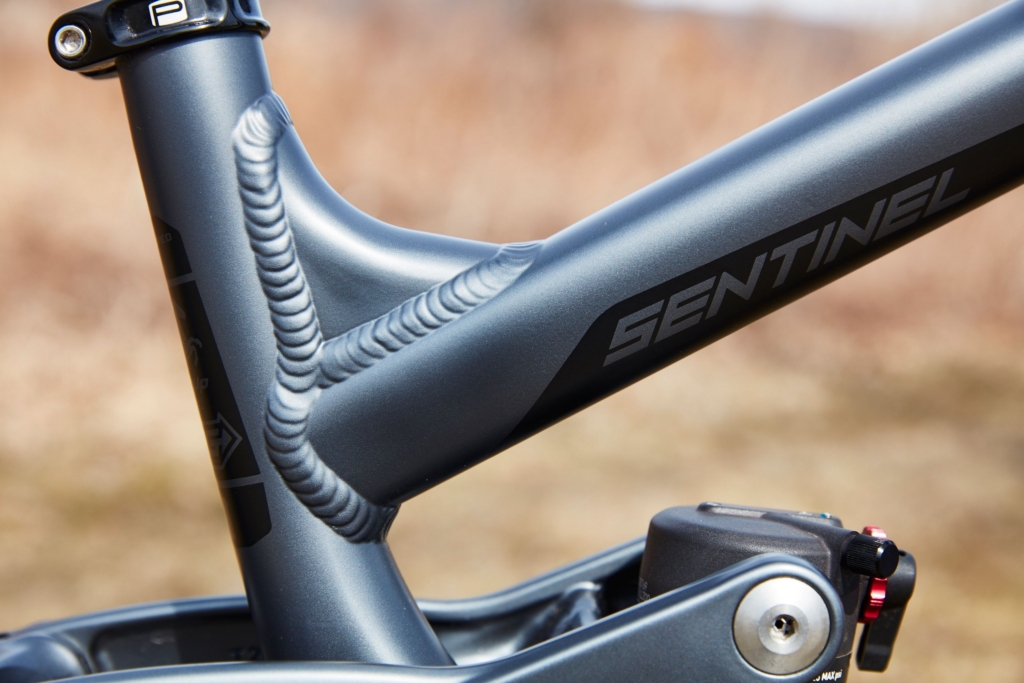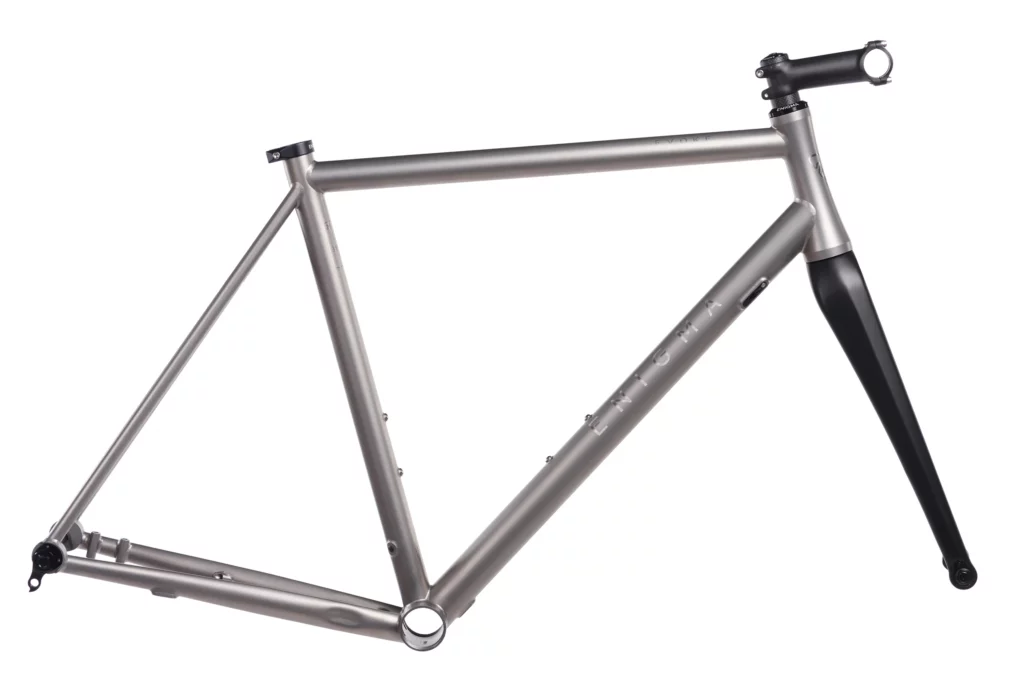Bike Frame Materials: A Complete Guide for Cyclists
Over time, bike frames have evolved, and we have seen a transition from predominantly steel frames to the more prevalent options of aluminum and carbon fiber. However, steel and titanium continue to maintain a significant presence in the market.
Selecting the ideal frame material for your bike depends on various factors such as your riding preferences, budget constraints, desired weight, and longevity of the frame. To gain a better understanding of the key properties of aluminum, steel, titanium, and carbon fiber, I reached out to two industry experts for their insights.
I had the pleasure of discussing the matter with Richard Lambert, a representative from Enigma, a leading UK-based titanium and steel bike specialist. Additionally, I spoke with Liam Glen, a mechanical engineer employed by Airbus who also boasts an impressive background as a former professional cyclist and the winner of the 2021 Highland Trail 550 bikepacking race. Liam even shared with us a gallery of his remarkable singlespeed Stooge Cycles Scrambler.
With their valuable input, I am confident in providing you with a comprehensive understanding of the different frame materials available, enabling you to make an informed decision when purchasing your next bike.
Common Bike Frame Materials
First, let’s dive into the four common frame materials: Steel, Aluminum, Carbon, and Titanium.
Steel bike frame
As we both know, steel is the old-school champ. It’s been around since bikes were invented (1868) and offers excellent durability and easy repairs.It is mean that you could use your bike for longtime.

Steel frames are primarily constructed using one of two methods: with lugs or without.
In lugged frames, tubes are inserted into cast steel lugs at their joints and then brazed together. Conversely, non-lugged frames feature tube junctions that are either welded together or fillet brazed.
Historically, lugged construction was quite popular, with classic steel frames often showcasing intricate fretted lugs. However, welding generally results in lighter frames and requires less post-construction clean-up compared to brazing, which typically leaves excess material at the joints that must be removed.
Despite its disadvantages, Glen points out that brazing demands a lower temperature than welding, which likely leads to less alteration of the steel’s properties and, ultimately, a stronger joint.
Similar to aluminum alloy frames that later on we are going to talk about, steel tubes are usually butted to reduce weight. Modern steel frames also exhibit a wider variety of tube shapes as opposed to traditional round sections.
Classic has its features, however, it’s not as stiff as carbon and has a higher weight than other materials. Also, steel can rust over time if not properly maintained. If you want to ride a bicycle with this material, in addition to paying attention to the weather, it is also very important to maintain it afterwards, diligent wiping the frame and drying it upside down, and applying anti-rust oil to protect it.
Wide variety of steels bike frame

Reynolds, a renowned steel tubing producer since 1898, offers a wide variety of steel types. High-performance steel bikes typically use chromoly steel, while budget-friendly, lower-end frames feature high-tensile steel.
Various steel compositions yield different characteristics. For instance, Reynolds 531, a popular bike frame alloy, consists of specific proportions of manganese, carbon, and molybdenum.
Modern options from tube providers like Dedacciai and Columbus have expanded the selection. Steel’s versatility allows for an array of tube compositions and profiles, enabling the construction of sturdy frames for touring or lighter-weight frames, depending on the choice of materials.
Stainless steel is another alternative. Although generally weaker than chromoly steel, specialized stainless steels have been developed for bike manufacturing that are equal to or stronger than chromoly, according to Glen.
Why Choose Steel Bike Frames

Steel bike frames have both advantages and disadvantages when compared to aluminum and carbon materials. Despite being heavier and costlier to produce on a large scale, steel’s strength, durability, and repairability make it a popular choice for certain types of bikes.
While steel is denser and heavier than aluminum, its strength allows for thinner-walled tubes that maintain stiffness. However, the weight difference remains a downside. Steel can be repaired more easily than aluminum or carbon fiber and has a fatigue limit, meaning it can endure stress without failure, unlike aluminum, which wears over time.
The natural damping properties of steel offer a comfortable ride, although it can’t match aluminum’s stiffness-to-weight ratio. Steel is often used for boutique and custom bikes, as well as touring and bikepacking frames, where weight is less critical. It provides better value than titanium, with durability and longevity being key factors.
However, steel frames must be painted to prevent external corrosion and can be coated internally to protect against rust.
Pros of a steel bike frame:
- Strong, durable, and resistant to fatigue
- Easy to repair
- Comfortable ride
- More affordable than titanium
Cons of a steel bike frame:
- Relatively heavy
- More expensive than aluminum
- Less advanced tube shapes compared to aluminum
- Prone to corrosion if not properly treated
Aluminum bike frame

Aluminum is the most common bike frame material. It also has a high strength-to-weight ratio, is relatively lightweight, and is more affordable than other materials.
Aluminum frames are also commonly referred to as “alloy,” which stems from the fact that pure aluminum is too soft to create a bike frame. Therefore, it is combined with other elements to modify its physical properties.
Indeed, all metal bike frames utilize alloys for this reason. For example, steel is an alloy of iron, while titanium is primarily alloyed with aluminum and vanadium.
When examining aluminum frames, you may encounter numbers such as 6061 and 7005, which represent the most prevalent aluminum alloys. These numbers indicate the additives, primarily silicon and magnesium, that are combined with the aluminum to create each specific alloy. The properties of each alloy differ slightly depending on the ‘recipe.’
Discussing the construction of aluminum bike frames, Glen emphasizes that “all metals display quite comparable strength-to-weight ratios.” He explains that factors like tubing width and wall thickness play a more crucial role in determining a frame’s strength than the material itself.
Aluminum tubing is relatively simple to manipulate, allowing for varying properties along its length. Typically, aluminum tubes are butted, which ensures stiffness where required and minimizes weight where possible.
Whereas, it’s not as stiff as carbon, and its durability may be inferior. Aluminum frames are not easily repairable and may corrode over time. Moreover, aluminum tends to offer a less smooth ride compared to other materials.
Why choose an Aluminum bike frame

Aluminum is a common material for budget bike frames, but it’s also popular for some high-performance road and mountain bikes. Aluminum alloy frames are generally lightweight, stiff, robust, and about a fifth of the price of carbon fiber.
An aluminum frame can be lighter than a similarly priced carbon fiber one, but high-end carbon frames will always be lighter. Aluminum’s lower density than steel allows for oversized tubing and thicker walls to achieve high stiffness while remaining light. Tube wall thickness of aluminum frames is typically double that of steel, and tube diameters are about 20-30% larger.
Historically, aluminum frames were considered uncomfortable due to their stiffness and lack of shock absorption, but modern frame building techniques and wider tires have improved their ride quality.
Although aluminum frames boast an impressive balance of strength, stiffness, and low weight, they can be prone to long-term fatigue, unlike steel and titanium. However, aluminum frames are typically less susceptible to crash or accidental damage than carbon frames. This makes aluminum popular for mountain bikes and a smart choice for budget-conscious road racers.
Pros of an aluminum bike frame:
- Stiffness-to-weight ratio
- Affordability
- Greater durability than carbon
Cons of an aluminum bike frame:
- Stiffness may result in a harsh ride quality
- Aluminum fatigues over time
- Difficult to repair
Carbon bike frame
Carbon is the high-tech option, offering the lightest weight and unmatched stiffness. It’s also very durable and allows manufacturers to create unique shapes for aerodynamic purposes.

Carbon fiber has been the preferred material for high-performance bike frames since Lance Armstrong’s victory in the 1999 Tour de France on a Trek 5500 OCLV. Carbon fiber’s adaptability allows it to be shaped and fine-tuned according to specific requirements, striking a balance between stiffness, comfort, and aerodynamic performance.
However, carbon fiber has its drawbacks. Carbon fiber bike frames can be quite expensive, reaching well into the five-figure range at the higher end of the market. Additionally, they may be more vulnerable to crash damage compared to other materials.
Carbon fiber bike frames are constructed using layers of carbon fiber (woven fibers in sheet form) embedded in an epoxy resin matrix. The carbon fibers provide strength, while the resin binds it together.
Glen explains that “carbon has the highest strength-to-weight per ply.” However, since it only applies in one direction, multiple angles are used in a bike frame. This results in a slight reduction in strength-to-weight, though it remains higher than other materials.
Most frames are created by layering many sheets of carbon fiber/resin material, called “prepreg,” with different grades and orientations used in various parts of the frame. For instance, Look claims that its 795 Blade frame is crafted using over 800 distinct pieces of prepreg.
According to Glen, “the resin imparts impact tolerance and compression strength to the frame.” As relatively few companies manufacture prepreg and many frames are produced by third parties, most frames utilize the same resins. Bike makers specialize in the lay-up process, which imparts unique qualities to their frames.
The mastery of lay-up adds another layer of complexity to carbon frame design. Bike brands also cannot predict how individual end-users will ride their frames, leading to some over-engineering to ensure that they can withstand abnormal loads, as Glen points out.
How is a carbon bike frame made?

Carbon bike frames consist of layers of carbon fiber sheets embedded in an epoxy resin matrix. Carbon fibers provide strength, while the resin binds everything together.
Carbon has the highest strength-to-weight ratio per layer but must be stacked at multiple angles in a bike frame, slightly decreasing this ratio. However, it remains higher than other materials. Frames are typically constructed by layering multiple sheets of carbon fiber/resin material, known as “prepreg.” Different grades and orientations are used throughout the frame, like Look’s 795 Blade frame, which incorporates over 800 pieces of prepreg.
Resin grants the frame impact tolerance and compression strength. With relatively few companies producing prepreg and many frames made by third parties, most frames use the same resins. Bike makers specialize in lay-up techniques, which give their frames distinct qualities.
Mastering lay-up adds complexity to carbon frame design. Bike brands can’t predict how individual users will ride their frames, leading to over-engineering to ensure they can handle abnormal loads, according to Glen.
Why choose a Carbon bike frame?
Carbon fiber, unlike metals, is anisotropic, meaning its physical properties vary in different directions. For example, wood can be easily split lengthways but is difficult to break across the grain. Carbon fiber shares this characteristic, making the layout of its pieces vital to the frame’s ride and strength.
The modulus of the carbon fiber used is also important. Higher modulus fibers are stiffer but more brittle, so a “high modulus” frame will be made from a mix of different carbon fiber grades. Higher modulus carbon fiber is more expensive, but it results in a lighter frame with the same strength.
Carbon fiber’s advantages are well known, as it allows for frames to be designed for specific demands and types of riding. Carbon frames can be extremely light and stiff, with complex aerodynamic tube shapes, while still considering ride quality and comfort.
However, like we mentioned, it’s expensive and carbon fiber is easily crushable, so it can be damaged in areas like quick-release drop-outs. Carbon bikes often have metal drop-outs, inserts for thru-axles, or metal protectors. Impacts can cause internal damage, which may not be visible but can lead to a frame breaking unexpectedly. If your carbon frame experiences a heavy crash, it should be inspected before riding again.
Lastly, recycling options for broken carbon frames are limited, while recycling metal frames is easier. Titanium, in particular, is valuable and unlikely to end up in a landfill.
Pros of carbon fiber bike frames:
- Excellent stiffness-to-weight ratio
- Highly adaptable
- Can be molded into aerodynamic tube shapes
Cons of carbon fiber bike frames:
- Expensive
- Prone to wear and crash damage
- Limited recycling options
Titanium bike frame

Titanium is the cream of the crop when it comes to durability and corrosion resistance. It boasts a unique appearance with thin round tubes and a distinct finish. However, titanium is heavier than carbon and can be very expensive.
It offers unique benefits as a bike frame material compared to other metals and it is less dense than steel, allowing for a lighter frameset with thicker-walled tubes. A titanium tube weighs half as much as a steel tube with the same tensile strength. For example, Enigma’s titanium tubesets are typically 0.9mm thick at their thinnest point, compared to 0.5mm for steel.
This makes titanium frames more resistant to denting, and since titanium doesn’t corrode, there’s no need for paint, eliminating concerns about scratches and chips. The raw finish characteristic of titanium frames is visually appealing, but they can still be painted if desired.
However, titanium is considerably more challenging to work with than steel, as noted by Enigma’s Lambert. He emphasizes the importance of cleanliness and controlling the welding process, particularly purging oxygen, for which Enigma employs argon gas.
In the past, there were limited titanium tubesets available, and they were not specifically designed for bikes. This led to a perception of titanium frames as overly flexible. However, Lambert asserts that this is no longer an issue, as there is now a broader selection of bike-specific tubing. Additionally, design features like tapered steerers and wider bottom bracket standards enable titanium frames to be tailored for stiffness according to the intended application.
Despite its reputation for delivering a comfortable ride quality when crafted by a skilled frame builder, titanium remains the priciest metal option, often surpassing the cost of a carbon frameset.
If money is not the limiting reason for you, then rare and precious titanium alloy materials will provide you with a more comfortable experience.
How to Choose a Bike Frame Material
Buckle up, buttercup! Keep in mind that no material is perfect. Each has its own set of pros and cons. It’s essential to weigh these factors against your conditions to make the best choice for you. Now, let’s talk about two main factors: personal aspects and riding style.
Budget
Determine how much you’re willing to spend on a bike. If you’re on a tight budget, aluminum might be go-to choice . Most bikes priced from $600 to $2,000 are made of aluminum. Above $2,000, you’ll start seeing some carbon-fiber options, but direct comparison of materials alone can be tricky due to differing equipment on bikes within this price range.
Priorities
When considering your priorities, think about the aspects of a bike frame that are most important to you. If weight is crucial, carbon might be the best choice, as it’s the lightest of the four materials. A lighter bike can be advantageous for riders who frequently tackle hills. On the flip side, if durability is your top priority, steel or titanium may be a better fit. Steel offers impressive durability and is easier to repair in case of damage. Titanium, while lighter than steel, still provides a robust and resilient frame.
Aesthetic preferences
Each frame material offers a distinct look that may resonate with different cyclists. If you’re after a classic, timeless look, steel might be right up your alley. Titanium, on the other hand, offers a unique appearance with a distinct, brushed finish that sets it apart from other materials. Carbon and aluminum, while not as distinctive as steel and titanium, still offer a range of aesthetic options.
Types of Riding
Road cycling
Road cyclists prioritize speed, efficiency, and performance. They typically ride road bikes with drop handlebars, narrow tires, and lightweight frames made of materials like carbon or aluminum. If you want to become a road cyclist who prioritizes speed and performance, carbon could be the ideal choice due to its light weight and stiffness.
Mountain biking
Mountain bikers are adventurous, off-road enthusiasts who seek the thrill of riding on rough, unpaved trails. They navigate diverse terrain, from rocky paths to muddy slopes and steep inclines.
Mountain bikers require bikes with robust frames, suspension systems, and wide, knobby tires for optimal traction and control. For mountain bikers who need a durable and rugged frame that can withstand rough trails, aluminum or steel might be a better option.
Cyclocross and gravel biking
Cyclocross is a specific type of racing that involves short, off-road courses with various obstacles, while gravel riding often involves longer distances on mixed surfaces. These riders require bikes with sturdy frames, wider tires for better traction, and drop handlebars for comfortable handling on various terrains. For mixed-terrain riding, steel or titanium frames offer a smooth and comfortable ride.
Bikepacking and touring
Bikepackers and touring cyclists are the long-haul travelers who embark on multi-day or even multi-week journeys, carrying all their gear on their bikes. They prioritize comfort, durability, and load-carrying capacity in their bikes.
Touring bikes typically have steel or titanium frames, wider tires for stability, and various mounting points for racks, fenders, and water bottles. Bikepacking bikes are similar but may lean towards more off-road capabilities, with features like wider tires and suspension forks. For long-distance comfort and load-carrying capacity, steel or titanium frames are excellent choices.
Conclusion
In conclusion, when choosing the best bike frame material, it’s crucial to consider your budget, priorities, aesthetic preferences, and riding style. By taking these factors into account and exploring specific examples of bikes in each category, you’ll be well-equipped to find the suitable bike frame for your cycling adventures. Remember, the best bike is the one that brings a smile to your face every time you ride it.
